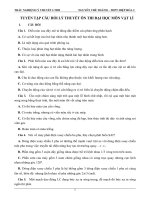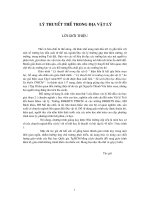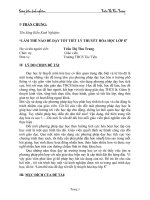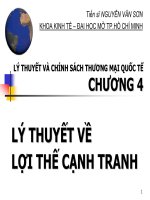THE PRESENT CONTINUOUS LY THUYET
Bạn đang xem bản rút gọn của tài liệu. Xem và tải ngay bản đầy đủ của tài liệu tại đây (100.93 KB, 10 trang )
THE PRESENT CONTINUOUS
USE 1: Now, at the very moment of speaking
Examples:
1. Please be quiet. The children are sleeping.
2. They are reading their books.
3. Look! Someone is trying to break into your car.
4. They are swimming in the pool.
Signal words: At the moment, Now, Just now, Right now, Listen!, Look!, At present
USE 2: Longer Actions in Progress Now
In English, "now" can mean: this second, today, this month, this year, this century, and so on.
Sometimes, we use the Present Continuous to say that we are in the process of doing a longer
action which is in progress; however, we might not be doing it at this exact second.
Examples: (All of these sentences can be said while eating dinner in a restaurant.)
1. I am studying to become a doctor.
2. I am reading the book Tom Sawyer.
3. At eight o’clock we are usually having breakfast.
USE 3 Near Future (plans, arrangements)
Sometimes, speakers use the Present Continuous to indicate that something will or will not
happen in the near future.
Examples:
1. I am meeting some friends after work.
2. I am not going to the party tonight.
3. I'm meeting my mother at the airport tomorrow.
4. My mother's going to the dentist tomorrow.
Signal words: In the morning, in the afternoon, in the evening, at noon, tonight, tomorrow, next
...
USE 4: Repetition and Irritation with "Always", “Constantly”, “Forever”
The Present Continuous with words such as "always" or "constantly" expresses the idea that
something irritating or shocking often happens. Notice that the meaning is like Simple Present,
but with negative emotion. Remember to put the words "always" or "constantly" between "be"
and "verb+ing."
Examples:
1. Johny is always asking stupid questions!
2. Why are you always criticising me?
3. She is always coming to class late.
4. He is constantly talking. I wish he would shut up.
5. I don't like them because they are always complaining.
6. It’s always raining in London.
7. You're constantly complaining about your mother-in-law!
8. Harry and Sally are always arguing!
Note: This use of the present continuous is not possible as a negative statement.
Use 5: To describe a temporary event or situation
1. I’m working in London for the next two weeks.
2. He usually plays the drums, but he's playing bass guitar tonight
Use 6: For something which is new and contrasts with a previous state (a trend):
1. These days most people are using email instead of writing letters.
2. What sort of clothes are teenagers wearing nowadays? What sort of music are they
listeningto?
3. More and more people are becoming vegetarian.
VERBS THAT ARE NOT USUALLY USED IN THE CONTINUOUS FORM
The verbs in the list below are normally used in the simple form because they refer to states,
rather than actions or processes.
assume
suppose
Forget
Envy
SENSES / PERCEPTION
to feelto hear
to see to smell
to taste
OPINION
believe
consider
doubt
feel (= to think)
think
MENTAL STATES
imagine
knowmean
notice recognise
EMOTIONS / DESIRES
fear
dislike
hate
hope
like
find (= to consider)
remember
love
mind
Prefer regret want
wish
MEASUREMENT
Contain
cost
hold
measure
weigh
OTHERS
look (=resemble)
seem to be (in most cases)
have( possess)
EXCEPTIONS
Perception verbs (see, hear, feel, taste, smell) are often used with can: : I can see... These verbs
may be used in the continuous form but with a different meaning
- This coat feels nice and warm. (your perception of the coat's qualities)
- John's feeling much better now (his health is improving)
- She has three dogs and a cat. (possession)
- She's having supper. (She's eating)
- I can see Anthony in the garden (perception)
- I'm seeing Anthony later (We are planning to meet)
Games
1. Make me say “Yes, I am”/ Make me say “No, I’m not”Students take turns asking yes/ no
questions that they think their partner will probably say “Yes, I am” to such as “Are you sitting
down?” and “Are you feeling tired?”. They get one point for each positive answer from their
partner, as long as no one has already used that question. Students might need a list of suggested
verbs such as “wear”, “think”, “worry”, “touch”, “move” and “carry”. You could also allow
sentences with your like “Are your eyelashes moving?”
2. Happening now brainstorming
Students look around the room and/ or out of the window and make as many true sentences as
they can about what is happening, e.g. “She is breathing” and “They are walking”. If you want
to score, give one point for each sentence that hadn’t been said before, perhaps allowing the
same sentence with a different subject (“He is breathing”, “We are breathing” etc.) with lower
level groups. If you are including actions in the classroom, you can encourage the other students
to do lots of actions for their classmates to make sentences about, or you can do the opposite
and encourage them to try and stay still and so only accidentally give their classmates
something to describe (e.g. “He is sniffing”). You might want to allow use of bilingual
dictionaries to boost the level of language used.
You can also do this game with only one person looking and the other people guessing what is
happening outside the window etc., with the person who is looking giving points for any
sentences which are both factually and grammatically correct.
3. What are you hearing?
Students guess what is happening from what they can hear. The sounds can be things happening
naturally in the class (“A clock is ticking”), sounds that the teacher or their classmates are
making deliberately (“You are kicking the table”), or things happening on a video or in a
recording. They obviously need to close their eyes for most of these, or their view can be
blocked, for example with a piece of cardboard in front of the TV or a blanket held up behind
which people make sounds. Students can just guess what action they are hearing (“Somebody is
moving their desk” etc.), who is doing it (“Who is coughing?” “Joao is coughing” etc.), or how
many people are doing it (“How many people are jumping?” “Seven people are jumping” etc.)
Suitable actions for students to deliberately make noises with in the classroom include “opening
and closing”, “knocking on”, “pushing”, “dropping”, “kicking”, and “turning”.
5. Present Continuous projects
Students draw the scene that they are told to and add as many pictures of people doing suitable
things for that situation as they can, with a written description for each. For example, students
work together to draw 20 or so people in a park and label each person with what they are doing.
The pictures can be drawn, cut from magazines, or found online. The same thing can also be
done with animals, robots, monsters, aliens etc. doing the actions.
The projects can be made more realistic and given context by making them advertising or
instructional posters, e.g. a poster of a theme park showing all the things that people are having
fun doing at one moment in time, or a poster showing all the things that are good and bad for
the environment that people are doing in a town right now.
6. I don’t know what he’s doing
Students try to ask questions about their partners’ families etc. that the person answering doesn’t
know the answer to, e.g. “What is your father doing?” and “Is your mother watching TV?”
You can also make this into a bluffing game by students answering all questions and the
questioners guessing which answers are made up, perhaps after asking for more details like
“Why is he/ she doing that?” and “How do you know?” Especially with this variation, students
can also answer questions about their partners’ neighbours, friends, local postal worker, boss,
teacher in other classes, etc.
7. Present Continuous time zones guessing game
Using a map, globe or list of time zones, a student chooses a country and describes what is
probably happening there now without saying its name, e.g. “They are sleeping on futons” or
“They are eating tacos and playing guitars”. As well as matching the country, the sentence must
reflect the time in that place (by students calculating from the time differences). Students
continue giving hints until their partner guesses which country they are thinking of.
8. Present Continuous picture search
Students are given magazines, catalogues or books that include lots of pictures of people doing
different things, e.g. fashion magazines, picture dictionaries or visual encyclopaedias. Different
people can have the same books etc or different ones each. Students search for pictures that
match what the teacher or a classmate says (e.g. “Someone is running”) as quickly as possible.
They can also search for a picture and sentence that no one else can find, or search for a picture
and sentence that no one has said yet.
This game can also be played with people spotting things in single very detailed pictures such
as pages from a “Where’s Wally?” book.
9. I’m still not getting through
Students roleplay telephone conversations where one person is trying over and over to get
through to the same other person, with the receptionist who answers giving a different reason
each time why that person isn’t available. This should eventually lead to more unusual and
amusing excuses like “He’s out jogging”. Students can then brainstorm and rank good and bad
excuses in that situation, and maybe try the same activity again.
10. We’re boasting on the phone
Students take turns describing the perfect scene where they are, trying to out do the other person
with how wonderful the situation they are in is, for example “The sun is shining and the birds
are singing” “That sounds nice. Here are millions of stars are twinkling and a few flakes of
perfect snow are falling slowly from the sky”. You can ask students to imagine specific scenes
such as particular countries, tourist resorts, or holiday homes. It is also possible to do it the
other way round, with students “boasting” how awful the situation they are in, with situations
like holidays, city living, shared housing and jobs.
11. Present Continuous memory games
Students describe what is happening now from memory, i.e. without being able to see what they
are speaking about. The simplest way of organising this is for students to close their eyes and
answer questions about what is happening around them, e.g. “Where is John sitting?” and
“What colour shoes is Jeremy wearing?” Alternatively, they can brainstorm everything that they
can remember without questions to prompt them.
The same thing can be done with a picture that is turned over or scene from a video that is
turned off, probably after they look for 30 seconds and try to memorise it first.
14. Present Continuous Kim’s game
Students step out of the class, close their eyes or look away. When they look again, they should
list the things which have changed, e.g. “Henry is wearing a jacket” or “The teacher is sitting
down” because those things changed while they weren’t looking. They can also do the same
thing with pictures with differences (“The old woman is drinking coffee” because that was
different in the first version of the picture that you showed them) or two scenes from a video
(“She is wearing his jacket” because that has changed while the video has been turned off). The
videos and photos can also be made by students if you have the equipment.
15. Present Continuous instructional play
Students design and act out a play showing someone doing lots of wrong things such as things
that are bad for the environment, things which aren’t allowed in school, or things which are
dangerous. One of the people in the group or someone in the audience shouts “Stop” when
something bad happens, the people acting freeze, and their teammate or someone from the
audience says what bad thing is happening which shouldn’t be, and why it shouldn’t be done.
The same thing can easily be done with the teacher doing the actions, or with students filming
their plays on video cameras.
16. Present Continuous 20 questions
One student thinks of a verb and the other person asks questions like “Am I doing this now?”,
“Are you doing this now?”, “How many people in the world are doing this now?”, “Are most
people in Brazil doing this now?” etc until they guess which action is being thought of. The
students will probably need suggested questions like these, and maybe a list of possible verbs
like “breathe” and “sit”.
17. Present Continuous picture similarities and differences
Give students pictures of two busy scenes, e.g. two street demonstrations, two pictures from
Where’s Wally (= Where’s Waldo) books, or two photos of crowded town squares. Without
showing their pictures to each other, students must find Present Continuous sentences that are
true of both pictures or are only true of one (depending on what you tell them to do). It’s
obviously usually easier to find differences than similarities in such real pictures.
Many books also have photocopiable version of this, usually with each pair of students having
the same picture with five or ten small variations, similar to a children’s spot the difference
puzzle but again with students doing it without looking at each other’s pictures. It’s quite
difficult to make your own versions of this, because if you Tippex a picture and make changes
it’s usually too obvious where you’ve done so. Although this is less satisfying than a single
picture, the same thing works with twelve or so ClipArt pictures of actions on the worksheets,
with four or five of them being at least slightly different.
18. Present continuous tennis
Students “serve” an “I” Present Continuous phrase or sentence such as “I’m skiing” or “I am
taking a photo”, their partner returns with the second person form of the same thing, e.g.
“You’re skiing”. This continues through all the subjects that you want to practise. To “return”,
the next person must then choose another verb or sentence to continue the game with such as
“I’m feeling hungry”. If anyone makes a mistake or pauses for too long, they start again with a
serve with a new verb. This continues until someone has reached the number of points that you
set them as a goal, or the person with highest number of points when you stop the game wins.
19. Bad and worse actions
Students take turns “boasting” about how annoying their (imaginary) spouse, parents, teacher,
friend, siblings etc. are using Present Continuous, e.g. “My brother is always picking his nose”
“That’s nothing. My sister is always picking her nose and eating it”. Whenever both sides run
out of ideas, they discuss which person actually sounds more annoying and/ or guess how much
of that was actually true about their real sister etc.
20. We are cutting
Students cut up scrap paper into the shapes of people (or animals, robots etc.) doing actions.
This can be producing what the teacher or a classmate says (e.g. “A horse is running”, with
points for the quickest and/ or best options), or trying to come up with as many shapes and
matching sentences as possible (written and/ or spoken).
21. He’s doing that first
Students are dealt out pictures which should be in some kind of order such as a cut-up comic
strip (with no dialogue). They have to describe what is happening to put them back into order
without showing them to each other, e.g. “In my picture a boy is tying someone’s shoe laces
together” and “In my picture a man is falling over, so it must be after yours”.
22. Present Continuous miming games
Miming sentences like “You are drinking tea” and “A gorilla is beating its chest” is by far the
most obvious thing to do with the basic meaning of Present Continuous, as it means students are
using the tense as they see an action in progress. To make that true, the teacher or students
should always continue doing the action until the people watching guess what is being done (so
that it is not more accurate to say “You jumped” or “You were jumping”).
It’s also possible for students to come up with their own things to mime. A nice way of doing
this is to give them a verb and ask them to take turns making actions that go with it, e.g.
“You’re having a bath”, “You’re having breakfast” and “You’re having a good time” for
“having”. This can still be done as a guessing game, or students can get one point for each
action they can both say and do. Students could also work in mixed-sex groups so that they can
get one point for each of “I’m swimming”, “We’re swimming”, “He’s swimming”, etc.
A variation that involves both the teacher giving ideas and students coming up with their own is
the teacher giving a list of complex processes such as “You are making pizza” and “You are
changing a bicycle tyre”. The students mime single actions from that process one by one, with
their classmates trying to guess both the actions and the larger process, e.g. “You rolling some
dough. You’re making cookies.” “I am rolling some dough but I’m not making cookies. Here’s
the next action”.
Livelier classes might prefer to race to do the mime that the teacher chooses, with one point for
the first correct mime. To make it match the meaning of being in progress, the sentence will
need to be held up and left up while the miming is going on, or shouted out over and over (by
the teacher and/ or by the people doing the mimes).
Guessing and doing mimes can be made more challenging and fun by the mimes being made
with just hands (e.g. two fingers down representing a standing person), shadows, puppets, soft
toys, etc.
Another kind of miming challenge is for two or more students to try to exactly mirror each
other’s actions, with the people watching trying to spot and point out differences, e.g. “He’s
jumping but she’s hopping” or “She’s winking one eye but he’s blinking both eyes”.
You can add cultural training to these activities by having gestures that vary by country, e.g.
“You are calling a waiter” or “You are telling someone that it’s a secret”.
23. Present Continuous drawing competitions
Present Continuous drawing competitions can be to draw a sentence until the people watching
guess what the sentence is, rush to make the fastest and/ or best picture of the sentence that the
teacher or a classmate says (“She’s playing with a yoyo” etc), or draw and write as many correct
Present Continuous sentences as they can on the topic given (“At school” etc) within the time
limit.
24. Make them doing it
Students arrange slips of paper with words written on them to make sentences like “He + is +
wearing + long + pink + socks” and “The + lion + is + sleeping”, then read out their completed
sentences.
You can ask them to make sentences of things that they’d like to draw on a picture, real things
that are happening in the classroom, things that they want people to act out, or just things that
could be true. Whether you want to then eliminate those slips of paper from the game or put
them back onto the table to be also used to make different sentences later is up to the teacher,
but the latter is usually better.
For students who have problems with reading and/ or grammar, you might want to provide
different kinds of words on different coloured paper and/ or different sizes of paper, e.g. all the
subject pronouns on small pieces of blue paper and all the verbs on larger green paper.
25. Present Continuous accusations
Students ask questions using the Present Continuous about bad things that they imagine their
partner is doing such as “Why are you hitting your brother?” or “Why are you wearing
underpants on your head?” Their partner must give a reason (i.e. they can’t say that they aren’t
doing it). The person who asked the question can reject bad reasons like “Because I hate him”
for “Why are you hitting your brother?” Note that students will probably need to be at least Pre-
Intermediate level to be able to explain their reasons in English. They will also probably need a
few on a worksheet to choose from before they start making up their own accusations.
26. This is what I’m saying
Make a list of functional language which is used in particular situations, e.g. “I would have
loved to, but…” for politely rejecting invitations or “Thanks for having me” when you leave
someone’s house. The teacher or a student says one or more phrase for one situation and the
other people guess the situation with a Present Continuous sentence, e.g. “You are rejecting an
invitation” or “You are leaving someone’s house”. More confident classes can also try this game
with just a list of situations (“Apologising” etc) before being given the phrases to use.
27. Bad habits sentence completion bluff
Students fill in the gaps in some sentence stems on a worksheet to make true and made-up
complaints about their neighbours, classmates, cousins, etc., e.g. “My mother is always telling
me ______________________” and “My bus driver is always _____________________ the
steering wheel”. Students fill in at least half of the sentences with a mix of facts and
imagination, then take turns reading out their sentences. After questions about details (during
which they can continue lying if the sentence was made up), their partners guess if the sentence
is true or false.
28. Shooting blind
This is based on a common use of Present Continuous in movies, namely someone working for
the secret services or police describing what is going on into a microphone. In the most
dramatic version of this game, one person is blindfolded and given something such as a pencil
to pretend is a gun. One person walks around the room and the other members of the class
describe what they are doing, using a Present Continuous sentence each time such as “He’s
walking in front of the whiteboard” and “He’s standing behind the teacher”. You’ll need to be
strict about use of this form so that they don’t just use prepositions of position. Whenever the
person with the “gun” feels confident of being able to shoot the right person (without hitting
any innocent bystanders and obviously without being able to look), they aim and make a
shooting noise. The rest of the class then judges how successful their shot was.
A less dramatic version is for the person to go around the room and suddenly commit some kind
of crime, with the blindfolded person deciding when to launch an arrest, with announcing too
early or late being a failure.
This can also be done with a video, with the person facing away from the screen deciding when
to shoot or arrest someone from the description of the people who can see what is going on.
29. Video activities for Present Continuous
Students can guess what is happening just from the sounds on a video and watch and check,
make as many true sentences as they can about a paused scene, shout out Present Continuous
sentences as the video is playing (getting no points if the action ends before they finish
speaking, as that would make the tense incorrect), or shout out Present Continuous sentences
from their worksheet when they think they are true. The last of those activities can be good
practice for typical confusions like “He is watching…” and “He is looking at…”, with points
taken off for sentences that are shouted out if they aren’t (exactly) true.
The shouting out their own ideas for what is happening can also be limited in some way, e.g.
only things which seem dangerous or naughty.
If you have access to videoing technology, groups of students could also make similar videos
for the whole class to do those activities with.
30. Pictures of Present Continuous
Students take digital photos of each other doing actions and then share them with the class. The
challenge can be to come up with pictures and Present Continuous sentences that no other group
has made, to take obscure photos that are difficult to work out the action from, or to take photos
to illustrate how to do or not to do something, e.g. different suitable and unsuitable
woodworking actions.
31. What are you seeing?
Students guess what action a picture shows even though they can only see a tiny part of it, it is
shrunk very small, or it is very blurred. It grows or becomes more and more in focus until they
get the right sentence.
This is also possible with pictures where the action is ambiguous due to the lack of information
in them, with things becoming as the teacher gives hints, a video slowly progresses or they race
to read the explanation in texts on the pictures.
This is easiest with a computer and projector, but can also be done with an overhead projector.
This is also possible without technology by hiding a card and revealing it bit by bit from behind
another card.
32. Celebrities now
Students search social media for what famous people are doing right now, with points for
actions which are probably still happening when they announce them to the class, plus maybe
bonus points for interesting information. All reports to the class should be in the Present
Continuous tense, e.g. “Justin Bieber is singing in Wembley Stadium”. This works best with
Twitter, because people don’t have to be a member or be “friended” to read the tweets. They
will need to make note of when the tweet was sent each time so that other people can judge
whether it is still ongoing or not.
33. Only one person is doing it
Students try to make Present Continuous sentences that (just about) make sense but have only
one result on Google or Google images. For example, I found that was true for “She is eating a
desk” or “He is chewing a feather”. Students will need to use quotation marks (or the equivalent
for other search engines) to make sure that other combinations of those words don’t come up as
results.
34. Present Continuous songs
Quite a few pop songs and children’s songs include a significant number of Present Continuous
sentences, with maybe the most famous being Tom’s Diner by Suzanne Vega. However, it’s
quite difficult to know what you can do with such songs to actually increase students’
understanding of or ability to use this tense. Many worksheets online just get students putting –
ing forms or be + ing into gaps, but unless they still have problems with subject + be or
contractions it is difficult to imagine that they learn much from such an activity. If you can get
students singing along, that should help them memorise the structure and some of the verbs and
collocations in the song. To reinforce that memory building, you could get them to sing along
from more limited clues than the full lyrics would provide such as lyrics with blanks, just verb
forms in the infinitive, or just pictures.
Personally, I’m a bit too embarrassed to have actual singing in adult and teenage classes, so the
job then is to find alternative things to do before, during and after listening to the song. Perhaps
the best way is to almost ignore the actual –ing form and have students guess the collocations
instead, e.g. joining subjects and verbs or verbs and objects, then listening to check. They could
also guess what –ing phrases they will hear from pictures and/ or a description of the situation
described in the song, then listen to check.
35.
Where are we?
ESL EFL Speaking and Writing Activity - Elementary - 25 Minutes
In this fun class activity, students write sentences in the present continuous tense to
describe what is happening in a particular place. The class then tries to guess where they
are. Each student is given a card. Students complete two sentences (clues) by putting the
verb into the present continuous and adding the correct form of the verb to be. They also
have to think of two more clues to describe what is happening. Students then read their
sentences aloud and the class tries to guess where they are.









